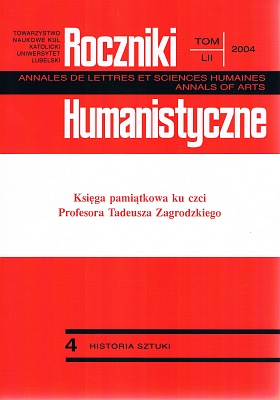Historical and artistic significance of the Crucifix of the Union of Lublin
Abstract
It is not known for how long the Crucifix of the Union of Lublin has belonged to the furnishing of the Dominican Fathers monastery in Lublin. Dispersed, and to a large extent destroyed archival records of the monastery do not allow reconstruction of history of that object that is linked by the Dominican tradition with the swearing-in ceremony of the Union of Lublin in 1569 and with Jan Matejko's painting.
The first part of the present article is an attempt at explaining the old tradition and comparing it to Matejko's artistic vision of Unia Lubelska (Union of Lublin). This required putting the Lublin crucifix in the context of the swearing-in on the basis of the diary of the Union of 1569. The records do not mention the crucifix. Its place is taken by the New Testament. The painter faced a similar problem; as a result he weaved the Dominican tradition in the source description of the event. Today it is hard to tell if the tradition of the Crucifix of the Union of Lublin is credible. It must have been generally known in the 19th century since Matejko learned about it. The Dominican cross made of ivory became inspiration for his painting. The artist willingly used a language full of allusions to painting and meanings hidden in objects. The symbol of the snake on the base made it possible to give a new direction to the interpretation of the cross: an enslaved nation, like Christ, will soon defeat the enemy power. The legend hidden in the reliquary for St. Stanisław's head, the gospel about resurrection, the cross as a sign of triumph, together form a pictorial vision of the fall and resurrection of the homeland.
The Crucifix of the Union of Lublin represents a group of small altar crucifixes made of ivory, often found in churches and monasteries all over Poland. They were especially popular in the baroque period. They were mass-produced in the Catholic countries of Europe, especially in France and Italy. Their distinguishing features are the rare and costly material – ivory – of which the figure was sculptured, and the wooden cross covered with black enamel. Two variations of presentations of Christ on the cross can be distinguished: that of Christ as an alive person, and as a dead one. The Lublin crucifix is an example of modern sculpture in ivory, with a new iconographical interpretation, presenting the alive Christ, raising his head to God the Father and uttering his last words at the moment of his death. The problem of the ivory sculpture in Poland has not yet been undertaken by Polish researchers.
Copyright (c) 2004 Roczniki Humanistyczne

This work is licensed under a Creative Commons Attribution-NonCommercial-NoDerivatives 4.0 International License.





